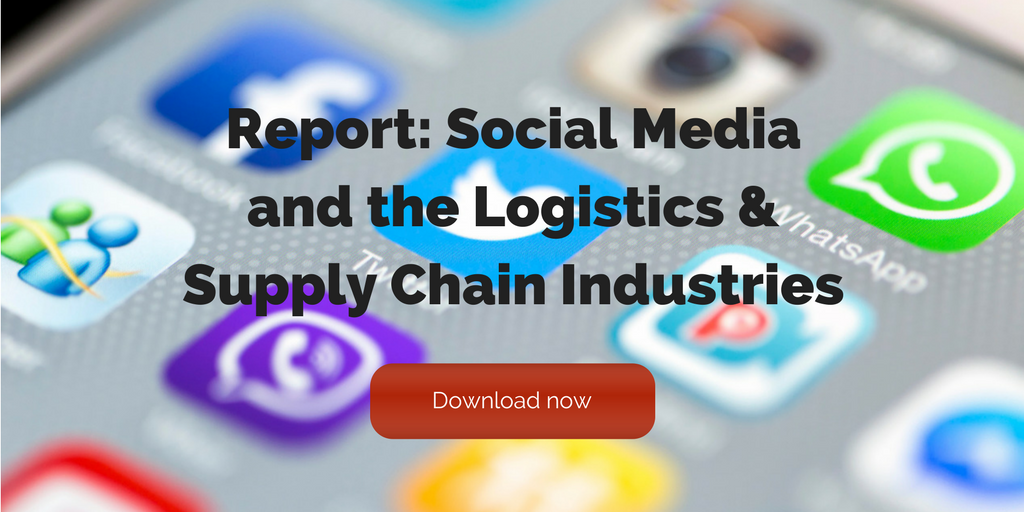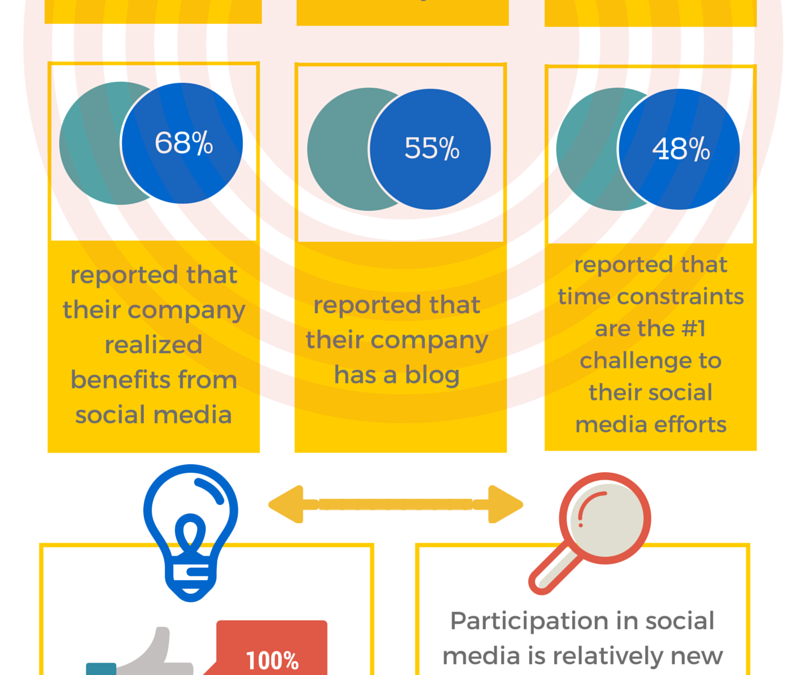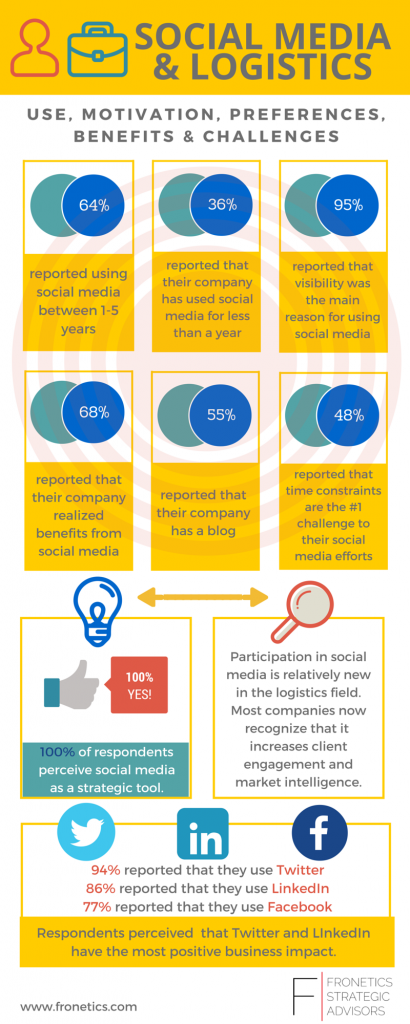
by Fronetics | Aug 6, 2015 | Blog, Logistics, Marketing, Social Media, Supply Chain, Transportation & Trucking

Transportation and logistics is a field that is booming. The business is a money-maker and a cornerstone of day-to-day functioning. It’s one that has been present for centuries. We are well past the Age of Discovery, but transportation and logistics companies carry on the torch of moving products that people need and desire around the world. One might wonder if the sultriness of the Silk Road and the Spice Trade has lost its allure and sexiness, but that needn’t be the case. Social media has brought about a fantastic opportunity for transportation and logistics companies to share their successes, display their offerings, create community, and convert leads.
Where to Start
First, think about it. Many transportation and logistics companies think about social media and how to use it, but cite a lack of time as a reason they haven’t explored the various platforms. Thinking about how social media can work for your logistics or transportation company is the first stop towards progress.
Second, learn about it. Understanding individual usage of social media versus B2B usage of social media is important. Do your consumers use LinkedIn, Facebook, Twitter? Where are your competitors finding success, and what platforms are they missing? Once you figure these things out the impulse will be to get started. Post away! Tweet away! Blog away! However, creating a Facebook page or a Twitter account will not draw in your community of employees or existing clients, and will not attract potential customers or clients. Having an account is great thing, but it’s not the most important thing. Knowing how to express your brand, what content to curate and create, and how frequently to share content is critical to social media success.
Learning is a process and takes time. Set up also takes time. Hiring an outside agency to do this work can both save you time, and will ultimately reap ROI. Marketing strategy companies have been doing this work already, and understand how to highlight your company. They know the market, and once they get to know you a bit better, you can work together to figure out how to express your brand through the platform of social media.
What to Highlight
Once you figure out who to focus on and how to reach that community, creating and curating your unique content is key. What is most informative and helpful to your clients? What will feel meaningful to them? What will catch and hold their attention? How do you want people to perceive you, your employees, and your products/services? Some studies have shown that conversion rates from social media can be 100% more effective than from outbound marketing, so getting this right could greatly benefit your company.
The joy of social media is its speed and its ability to humanize a company. A company’s Twitter feed is not like its white papers. Social media is known for personalizing things, so let people know the more human side of your business. Who are the drivers? Who are the employees? What are the success stories? Celebrate your community, partners, and clients. This is a place to engage with other businesses – to educate them and learn from them.
One perfect example of a logistics company that thrives in this arena is UPS. The logistics company has found success with unique, fun, interesting, frequent posts, tweets, and blogs. They also highlight their “heroes” by telling stories, often through video, of their heroic drivers who have been known to save lives. They show the human side of delivery. They connect. And when it comes to social media, it’s all about connection.
Two other examples of companies that excel in this area are Sourcemap and Transfix. Both companies have leveraged social media as a platform for growth. Sourcemap’s founder and CEO Leonardo Bonanni credits social media for the success for his business: “Sourcemap wouldn’t be here without social media.” For Transfix, social media and digital technologies enables the company to make the trucking industry more efficient and user-friendly.
Fronetics Strategic Advisors is a leading management consulting firm. Our firm works with companies to identify and execute strategies for growth and value creation.
When it comes to marketing we work with our clients to create and execute strategies that drive success and elevate their brand position within the industry. Unlike other firms, we align marketing programs with business objectives and, through a data driven approach, are able to deliver results with a targeted ROI. Our team is comprised of strategists, marketing professionals, writers, designers, and experts in social media. Together we leverage our experience to increase brand awareness, position our clients as thought leaders, drive meaningful engagement with prospects and customers, and help businesses grow.



by Fronetics | Jul 8, 2015 | Blog, Content Marketing, Marketing, Social Media

By creating and distributing valuable and relevant content in a strategic and consistent manner you create demand for your products and services and drive profitable customer action. That being said, while content is king, content doesn’t go far (actually it goes nowhere) without distribution. For content to be successful for your business you need to do more than create content – you need to distribute content. Moreover, the content needs to be delivered consistently over time, at the right time, and in the right place.
Wise words by BuzzFeed’s Jonathan Perelman: “Content is king, but distribution is queen and she wears the pants.”
So how often should you distribute content via social media? While it is important to find the balance that is right for your business, here is what we have found to be effective and what we recommend:
12 to18 per day
Twitter
Business users should aim to tweet 12 to 18 times per day, not including replies and retweets. Twitter is likely the only social media network where it’s acceptable to push content out to followers with heavy frequency, but Twitter doesn’t filter users news feeds in the same way that Facebook does, so the lifespan of a tweet is only around 15 minutes. To get the most out of your content, try repurposing or repackaging it and publishing it multiple times a day. This strategy ensures your content goes farther and gains more exposure. Use social tools like HubSpot or Sprout Social to schedule posts at different times throughout the day as publishing content ahead of time frees up your time to respond and engage with users in real time.
1 time per day
Facebook
Companies generally find that posting 1 time per day is their sweet spot for most social media networks. Facebook’s algorithm determines what content is shown to each user, so it’s likely that your followers won’t see everything your business posts. Ensuring that your Facebook posts offer high quality content will work heavily in your favor as users who engage with your content are likely to see your posts with greater frequency. And your content lasts longer on Facebook; according to wisemetrics, a Facebook post reaches 75% of its potential engagement in 5 hours. A median tweet reaches this 75% mark in less than 3hrs. Be cognizant though of posting too frequently on this network; Social Bakers reviewed the Facebook posting habits of several large brands and found a correlation between increased posts (defined as more than 3 per day) and the loss of page likes.
Instagram
As with Facebook, businesses posting to Instagram should aim to publish content once per day. The caveat with Instagram is that posts shouldn’t exceed more than one per day. Unlike other wordy social networks like Facebook and Twitter, Instagram is the place for your company to convey its brand with images. A recent study by Forrester found that Instagram users were 58 times more likely to like, comment, or share a brand’s post than Facebook users and 120 times more likely than Twitter users. With more than 300 million active users, businesses that have found a way to leverage Instagram are boosting brand engagement and growing its customer base at an incredible rate, most with only one post per day.
LinkedIn
Because office workers not only take a break from their offices on weekends, but also from LinkedIn, companies should aim to post content once per day during the workweek. In fact, in a guide published by the social network itself, ideal posting frequency for businesses is 20 times per month. Beyond posts published by your company once per day, individual users from your business should be encouraged to engage frequently with peers in activities such as asking and answering questions with LinkedIn’s Group feature. To provide the most value for your LinkedIn followers, content should be less promotional, and more heavily focused on industry-wide trends and insight.
Google+
Companies tend to find that for Google+, once per day postings generate the most value. With the social network’s obvious search engine connection, user engagement on Google+ might not be as high as say, Twitter or LinkedIn, but there are anecdotal reports that maintaining active company profiles allows content to be indexed quicker on Google. Research shows five times as many people read a Google+ headline rather than the actual content, so spend some time crafting great headlines that succulently convey your company’s message.
At the end of the day, optimal posting frequency for your company rests heavily on the type of audience it wants to reach; experiment with different posting frequencies and let your own analysis be your guide. There’s a fine line between annoying your social followers and providing value. Maintaining a dynamic and fluid posting strategy will ensure that your social efforts drive followers to action, rather than drive them away.
Fronetics Strategic Advisors is a leading management consulting firm. Our firm works with companies to identify and execute strategies for growth and value creation.
Whether it is a wholesale food distributor seeking guidance on how to define and execute corporate strategy; a telematics firm needing high quality content on a consistent basis; a real estate firm looking for a marketing partner; or a supply chain firm in need of interim management, our clients rely on Fronetics to help them navigate through critical junctures, meet their toughest challenges, and take advantage of opportunities. We deliver high-impact results.
We advise and work with companies on their most critical issues and opportunities: strategy, marketing, organization, talent acquisition, performance management, and M&A support.
We have deep expertise and a proven track record in a broad range of industries including: supply chain, real estate, software, and logistics.


by Fronetics | Jun 10, 2015 | Blog, Logistics, Marketing, Social Media, Strategy, Supply Chain
Fronetics Strategic Advisors conducted a survey focusing on social media and logistics and supply chain companies. Respondents shared information on their social media use, motivation, preferences, benefits, and challenges. One-hundred percent (100%) of respondents reported that they have used social media for five years or less, indicating that social media is a relatively new strategy for logistics and supply chain companies. Mirroring other industries, including those in Fortune 500 status, social media is playing an increasingly important role in company branding, marketing, and client engagement.
For the current state of social media and logistics, here is an infographic that summarizes many of the key points from the full report.


by Fronetics | May 6, 2015 | Blog, Leadership, Marketing, Social Media, Strategy
 There’s a great deal of buzz about social media in the business world – and for good reason. Marketing and communications professionals have made it de rigueur to tap into the popularity of social media networks to extend their brands into the digital world. But when it comes to executive use of social media, the field seems much more divided. Domo and CEO.com estimated that of the 500 leaders of the biggest companies in the US, 68% have no social media presence whatsoever. By leaving the social media management to marketers, these leaders are missing opportunities to connect with followers and expand their influence.
There’s a great deal of buzz about social media in the business world – and for good reason. Marketing and communications professionals have made it de rigueur to tap into the popularity of social media networks to extend their brands into the digital world. But when it comes to executive use of social media, the field seems much more divided. Domo and CEO.com estimated that of the 500 leaders of the biggest companies in the US, 68% have no social media presence whatsoever. By leaving the social media management to marketers, these leaders are missing opportunities to connect with followers and expand their influence.
Here’s why social media should be part of the game plan when it comes to matters of leadership.
Social media expands perspective.
Social media isn’t simply a mechanism for broadcasting company news or personal opinion. Many individual perspectives coalesce to create a social network. Asking questions of followers and participating in online discussions helps leaders gain new perspectives. Executives who do utilize social media tend to stick to LinkedIn at a rate greater than the general public, but increasing social participation beyond one network brings more heterogeneous insight and connects leaders to diverse groups.
Social media allows you to keep a finger on the pulse of industry trends and new research.
Participating digitally with like-minded professionals ties a leader into a broad network of resource-sharing. Having consistent access to relevant, curated articles about market and industry trends keeps leaders far ahead of peers who rely on just a few media outlets.
Social media connects your team.
Online social business tool Basecamp promises to help “wrangle people with different roles, responsibilities, and objectives toward to common goal.” Hosted in the cloud, Basecamp is a project management tool that helps managers and employees see exactly what’s happening with a given project. Its dashboard provides a snapshot of tasks and gives users – managers and employees – an opportunity to interact directly on the site. In addition to the real-time accountability it builds in, it also allows for real-time communication about projects, a concept that all but eliminates the need for private emails.
Social media inspires and motivates.
Hadyn Shaughnessy writes about top social media influencers in his contributing posts on Forbes.com. He believes stellar leadership is built firmly on relationships and that day-to-day operations of a business rely on a leader’s ability to connect, inspire, and mobilize employees. Leveraging social media is one way leaders are achieving that. But, he contends, passive consumers of social media – regardless of the number of followers – cannot be considered top influencers. Leaders who inspire are those who actively participate.
Social media builds relationships.
Among executives active on social media, the top benefit of maintaining “socialbility” is the direct access it provides to employees, media outlets, and the public. “Relationship building is one of the strongest skills sets related to leadership effectiveness,” says Jean Leslie, a researcher at the Center for Creative Leadership. Tying into social media networks allows leaders to establish connections with employees, building individual and collaborative relationships.
Leaders who embrace social media technologies are more agile and innovative; their companies are more likely to attract and retain top talent; and they tap more deeply into the ideas of their employees. It’s clear that there is value in social media, and for leaders looking to build the strongest brand for their company, it might not be just an option anymore.

by Fronetics | May 6, 2015 | Blog, Leadership, Marketing, Social Media, Strategy
 There’s a great deal of buzz about social media in the business world – and for good reason. Marketing and communications professionals have made it de rigueur to tap into the popularity of social media networks to extend their brands into the digital world. But when it comes to executive use of social media, the field seems much more divided. Domo and CEO.com estimated that of the 500 leaders of the biggest companies in the US, 68% have no social media presence whatsoever. By leaving the social media management to marketers, these leaders are missing opportunities to connect with followers and expand their influence.
There’s a great deal of buzz about social media in the business world – and for good reason. Marketing and communications professionals have made it de rigueur to tap into the popularity of social media networks to extend their brands into the digital world. But when it comes to executive use of social media, the field seems much more divided. Domo and CEO.com estimated that of the 500 leaders of the biggest companies in the US, 68% have no social media presence whatsoever. By leaving the social media management to marketers, these leaders are missing opportunities to connect with followers and expand their influence.
Here’s why social media should be part of the game plan when it comes to matters of leadership.
Social media expands perspective.
Social media isn’t simply a mechanism for broadcasting company news or personal opinion. Many individual perspectives coalesce to create a social network. Asking questions of followers and participating in online discussions helps leaders gain new perspectives. Executives who do utilize social media tend to stick to LinkedIn at a rate greater than the general public, but increasing social participation beyond one network brings more heterogeneous insight and connects leaders to diverse groups.
Social media allows you to keep a finger on the pulse of industry trends and new research.
Participating digitally with like-minded professionals ties a leader into a broad network of resource-sharing. Having consistent access to relevant, curated articles about market and industry trends keeps leaders far ahead of peers who rely on just a few media outlets.
Social media connects your team.
Online social business tool Basecamp promises to help “wrangle people with different roles, responsibilities, and objectives toward to common goal.” Hosted in the cloud, Basecamp is a project management tool that helps managers and employees see exactly what’s happening with a given project. Its dashboard provides a snapshot of tasks and gives users – managers and employees – an opportunity to interact directly on the site. In addition to the real-time accountability it builds in, it also allows for real-time communication about projects, a concept that all but eliminates the need for private emails.
Social media inspires and motivates.
Hadyn Shaughnessy writes about top social media influencers in his contributing posts on Forbes.com. He believes stellar leadership is built firmly on relationships and that day-to-day operations of a business rely on a leader’s ability to connect, inspire, and mobilize employees. Leveraging social media is one way leaders are achieving that. But, he contends, passive consumers of social media – regardless of the number of followers – cannot be considered top influencers. Leaders who inspire are those who actively participate.
Social media builds relationships.
Among executives active on social media, the top benefit of maintaining “socialbility” is the direct access it provides to employees, media outlets, and the public. “Relationship building is one of the strongest skills sets related to leadership effectiveness,” says Jean Leslie, a researcher at the Center for Creative Leadership. Tying into social media networks allows leaders to establish connections with employees, building individual and collaborative relationships.
Leaders who embrace social media technologies are more agile and innovative; their companies are more likely to attract and retain top talent; and they tap more deeply into the ideas of their employees. It’s clear that there is value in social media, and for leaders looking to build the strongest brand for their company, it might not be just an option anymore.








